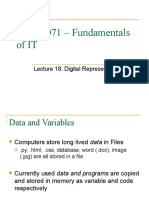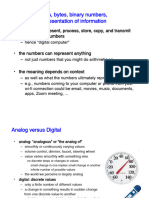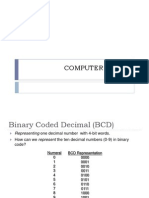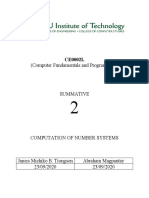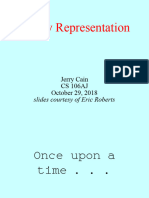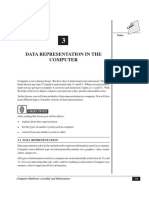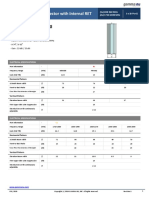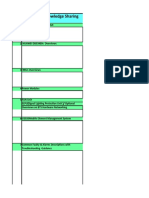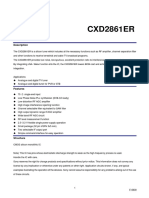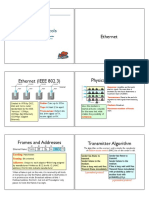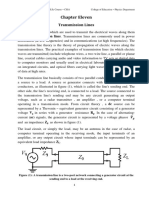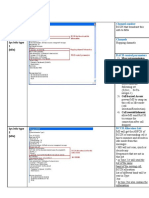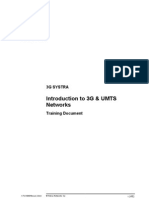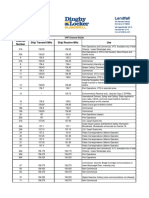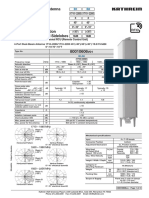5/25/20
Lesson 2
Everything Binary
Bits basic concepts and how are bits used to
represent information
Bits
• In computer systems, data is stored and represented
in binary digits, called bits.
• A bit has two possible values, 0 or 1.
• How many possible values with two bits?
• How many possible values with three bits?
• Do you see a pattern?
Number of Possible Values
• n bits can represent 2n different things;
• More bits can encode more information;
• More bits require more computer storage for each
thing encoded;
• 1 byte (= 8 bits) is the smallest storage unit used on
modern computer;
1
� 5/25/20
So Many Bits and Bytes...
• The number of bits to encode information especially
for digital media are very large.
• We use prefixes, such as mega and giga, to better
conceive the number of bits and bytes of computer
storage.
Prefixes
Prefix Name Abbreviation Size
Kilo K 210 = 1,024
Mega M 220 = 1,048,576
Giga G 230 = 1,073,741,824
Tera T 240 = 1,099,511,627,776
Peta P 250 =
1,125,899,906,842,624
Note the size is computed by the exponential of 2.
The exponent is increased in a step of 10,
i.e. 210 , 220 , 230 , 240 , 250 , ...
It is NOT 103 , 106 , 109 , 1012 , 1015 , ...
5
To Understand Binary Numbers, We Need to
Understand Decimal Notation (Base-10)
• Commonly used in our daily life
• Use combinations of 10 different numerals to
construct any values
• The 10 different numerals are:
0, 1, 2, 3, 4, 5, 6, 7, 8, 9
2
� 5/25/20
Base-10 Example
The decimal number 5872 is interpreted as follows.
5 0 0 0
8 0 0
7 0
+ 2
5 8 7 2
Base-10 Example
In other words,
5 8 7 2
= 5 x 103 + 8 x 102 + 7 x 101 + 2 x 100
= 5 x 1000 + 8 x 100 + 7 x 10 + 2 x 1
= 5 000 + 8 00 + 70 + 2
= 5872
8
Binary Notation
Base-2
• Used in machine language (language that computers
understand);
• Use combinations of 2 different numerals to
construct any values;
• The 2different numerals are 0 and 1.
3
� 5/25/20
Base-2 Example
The binary notation 1011 is interpreted as follows.
1 0 1 1
= 1 x 23 + 0 x 22 + 1 x 21 + 1 x 20
= 1 x8 + 0 x4 + 1 x2 + 1 x1
= 8 + 0 + 2 + 1
= 11 (eleven, in decimal notation)
10
Base-2 to Base-10
• The previous slide shows the base-2 to base-10
conversion method.
• 10112 (one one zero one) represents 1110 (eleven).
• The subscript indicates the base.
• A video tutorial:
https://www.youtube.com/watch?v=lnC7h6fgglU
11
Base-10 to Base-2
To convert base-10 to base-2 notation:
1. repeatedly divide the decimal number by 2 until it
becomes 0, noting the remainder of each division.
2. The reverse order of the sequence of the
remainders is the binary representation of the
decimal number.
12
4
� 5/25/20
Base-10 to Base-2 Example
To convert 1910 to binary notation:
19 / 2 = 9 remainder 1
9 / 2 = 4 remainder 1
4 / 2 = 2 remainder 0 100112
2 / 2 = 1 remainder 0
1 / 2 = 0 remainder 1
13
Decimal to Binary Conversion
• A complete video tutorial:
https://www.youtube.com/watch?v=rsxT4FfRBaM
14
Use Binary for Text: ASCII
• ASCII stands for American Standard Code for
Information Interchange
• By assigning unique numbers to each text character;
• An encoding standard for text characters, including
the 26-letter English alphabets and symbols in
computer programs.
15
5
� 5/25/20
ASCII
• For ASCII character set, each character uses 8 bits.
• With 8 bits, you can encode 28 = 256 different
characters.
• http://www.theasciicode.com.ar/ shows the entire
ASCII table, which contains 256 different characters.
16
For example, the character A is represented by 65.
http://www.theasciicode.com.ar/
Binary to Letter
• 65 in binary is 1000001 which contains 7 bits, we add
0 to the beginning to make it: 01000001, which
contains 8 bits (1 byte).
• Activity assignment (see assignment).
18
6
� 5/25/20
Using bits to represent images
• Bitmap images, such as digital photos
– color value of each pixel encoded into bits
• Vector graphics, such as graphics created in Flash
– coordinates of anchor points encoded into bits
– tangent of each anchor points encoded into bits
• Bitmap images, vector graphics, and pixels will be
explained in the digital images chapters
19
Using bits to represent sound
• sampled audio
– amplitude for each sample encoded into bits
For CD quality audio, it has 44,100 samples per second of the
audio
• MIDI music
– each musical instrument has an ID which can be encoded into
bits
– each musical note has an ID which can be encoded into bits
• Sampled audio and MIDI will be explained in the audio
chapters
20
Using bits to represent program
instructions
For example, an arithmetic addition may be represented
by a sequence of bits:
001100
21
7
� 5/25/20
File Sizes
• In a text document that uses ASCII code to
represent text characters, each byte stores an ASCII
code that corresponds to a character.
• The more characters in a text document, the more
bytes are required to store the file.
• Digital media files (image, sound, and especially
video files) can be very large.
22
Disadvantages of Large File Size
• take more storage
• take longer to send the file over the Internet
• take longer to process (such as during opening and
saving) the file
23
Strategies to Reduce Digital Media
File Size
• Reduce the sampling rate
• Reduce the bit depth
• Apply file compression
• There are lossy vs. lossless compression;
• Lossy compression: information lost during compression
to reduce file size;
• Lossless compression: information reorganized and
restructured to reduce file size, but no information is lost.
24
